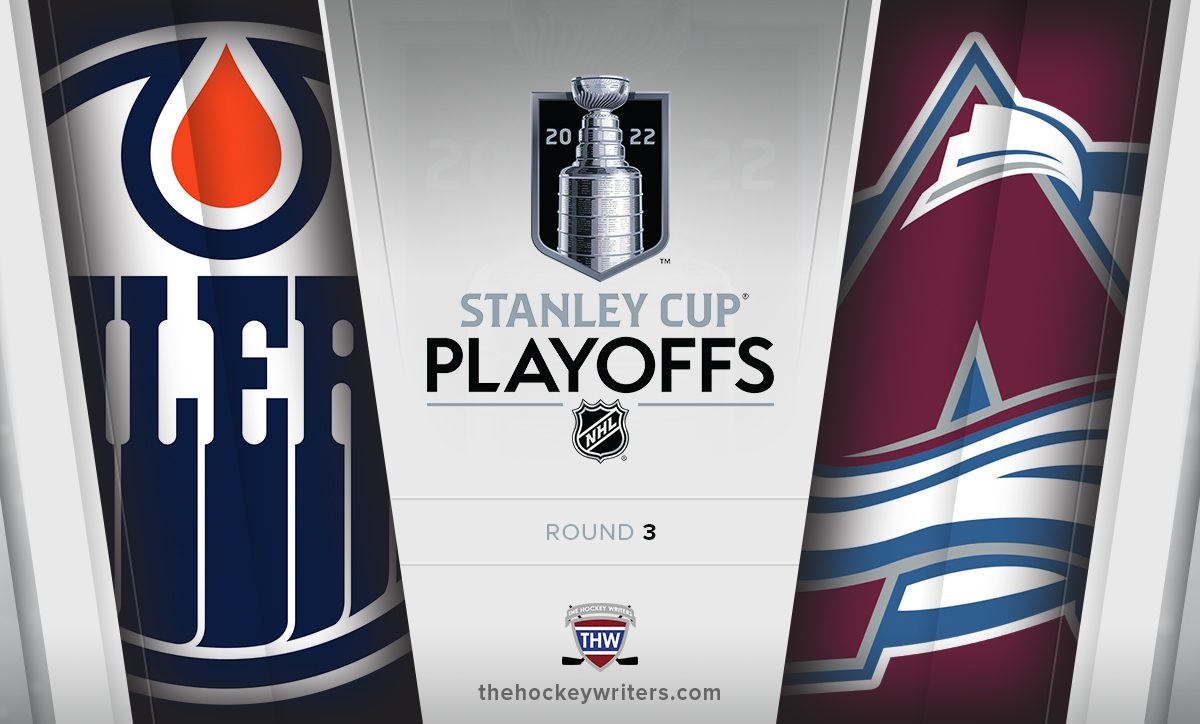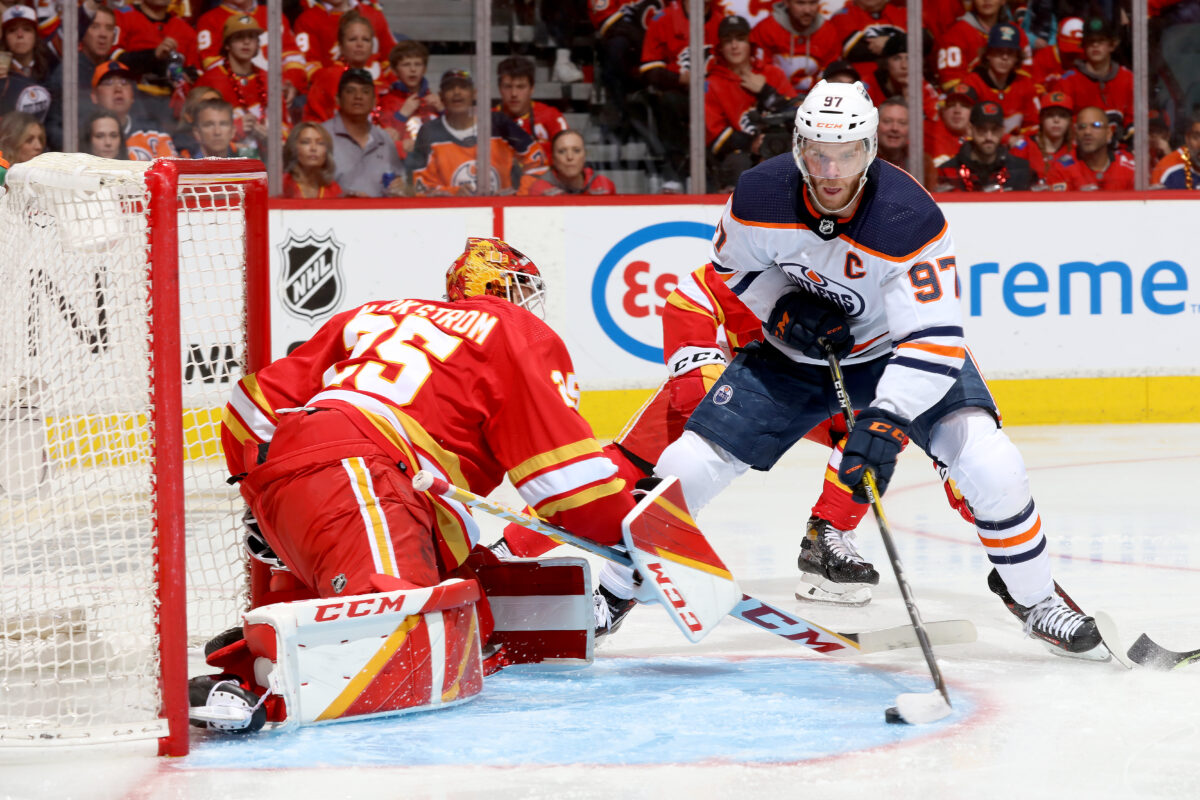In dispatching the troublesome St. Louis Blues in six games, the Colorado Avalanche advanced to their first Western Conference Final since 2002. The Connor McDavid-led Edmonton Oilers represent the final obstacle prior to the Stanley Cup Final, and his Herculean efforts in these playoffs thus far paint a terrifying picture of what is to come in this series.

Of course, the outcome of this series will come down to more than a single player and Edmonton has drastically improved its depth in recent years, but as McDavid goes, so do the Oilers. With that, here are five key storylines that are set to define this series and determine which team will represent the Western Conference in the 2022 Stanley Cup Final.
Avalanche Team Defense vs. McDavid’s Individual Brilliance
In spite of their identity as an offence-first juggernaut, the Avalanche play a stifling brand of team defence which revolves around stymying neutral zone play and swarming onto loose pucks. During an injury-riddled regular season, the team ranked ninth in chance quality allowed (xGA/60) and sixth in scoring chances allowed per-60-minutes (SCA/60) at 5v5. With a full roster in the playoffs, they rank first in shots allowed (SA/60), xGA/60, SCA/60, and high-danger chances allowed (HDCA/60). On the defensive side, only their woeful penalty kill (11th in the playoffs) and subpar goaltending have prevented a clean sweep through the first two rounds.
Still, even the most comprehensive defensive gameplans can struggle to shut down players capable of dizzying individual brilliance. For the Oilers, McDavid is the great equalizer and if he maintains his supernova pace in Round 3, they could become the surprise Western Conference representative in the Stanley Cup Final. Among skaters to have played in at least 12 games (McDavid’s total) in a single postseason, the Oilers’ superstar is scoring at the fifth-highest point-per-game (P/G) pace in NHL history (2.17). Only Wayne Gretzky and Mario Lemieux have posted more productive playoff campaigns, and no one in the salary cap era has come close (although Leon Draisaitl is tied with McDavid in these playoffs).
Of the teams the Oilers will have faced in these playoffs, the Avalanche are best-equipped for containing McDavid’s speed. He is likely to be fed a healthy dose of Devon Toews and Cale Makar, two of Colorado’s strongest skaters who also possess the wherewithal to make sensible defensive decisions. The absence of Samuel Girard, who suffered a season-ending injury against the Blues, hurts as he represents another outwardly mobile option on the Avalanche’s blue line. Rising star Bowen Byram has flashed his pedigree in these playoffs, but any matchups with McDavid should be his toughest test to date.
As a result, expect Oilers head coach Jay Woodcroft to deploy his superstar center against the likes of Jack and Erik Johnson when he has the chance, two defenders who either struggle with chance suppression or are no longer the most fleet of foot. If McDavid is brought down to Earth (relatively), the Avalanche’s depth should be able to overwhelm the Oilers throughout the rest of the lineup.
Oilers Power Play vs. Avalanche Penalty Kill
Given how much trouble the Blues’ power play gave the Avalanche, the Oilers must be salivating at the prospect of trotting out their offensive superstars on the man-advantage in this series. Colorado’s penalty kill is currently running at a 73.1% success rate for the playoffs, 11th out of 16 teams. It was even worse against the Blues at only 69.2% (9 for 13), which let St. Louis crawl its way back from the brink on several occasions.
The nature of the salary cap dictates that every team has a fatal flaw, with the financial constraints keeping them from papering over the cracks. For the Avalanche, their shorthanded prowess (or lack thereof) nearly threatened their ability to reach their Stanely Cup potential. In comparing their penalty kill to the Oilers’ power play, it becomes evident where Edmonton can create some momentum.
| Avalanche | Oilers | ||
|---|---|---|---|
| PK% | 79.7 (15) | 26.0 (3) | PP% |
| GA/60 | 7.34 (15) | 9.71 (3) | GF/60 |
| xGA/60 | 7.91 (25) | 9.55 (1) | xGF/60 |
| SCA/60 | 55.2 (18) | 65.4 (2) | SCF/60 |
The Oilers’ power play was a top-three unit during the regular season, one of the league’s elite groups capable of manufacturing scoring chances and converting at will. Their efficiency and chance generation have slowed slightly during the postseason but they rank fifth leaguewide in overall conversion, as well as SCF/60 and xGF/60. They scored on over a third of their opportunities against the Los Angeles Kings, but only on a fifth of their chances against the Calgary Flames. The Avalanche’s penalty kill is more vulnerable than that of the Oilers’ provincial rivals, so things could get ugly if that aspect of their game isn’t shored up in time.
Since the start of the 2019-20 season, only McDavid (124) and Draisaitl (117) have cracked the century mark for powerplay points. Florida Panthers winger Jonathan Huberdeau sits in a distant third, tallying a paltry sum of 91 points with the man-advantage over that time. Adding a troubled, but potent marksman in Evander Kane (43rd in powerplay goals since 2019) introduces another dependable offensive weapon to the mix.

The Avalanche will have their hands full, so discipline will be a key tenet of head coach Jared Bednar’s pre-game discussions. They took the 12th most minor penalties during the regular season but have toned it down in the playoffs, ranking 12th out of 16 teams in the same department. If they can keep the Oilers’ power play off of the ice, one of Edmonton’s primary avenues of scoring will be neutralized. As with anything involving stemming the tide of McDavid and Draisatil, that’s easier said than done.
Avalanche Rush Offense vs. Oilers Zone Entry Defense
The Avalanche have crafted an identity as being a team which plays at full tilt, using their speed through the neutral zone to manufacture goalscoring opportunities. Only the Florida Panthers and Toronto Maple Leafs generated more zone entries that led to a scoring chance per-60 during the regular season. Gaining the zone with control of the puck allows the team to set up its offensive sets as planned, and puts the opposition on the back foot.
Their emphasis on speed and skill throughout the lineup creates a compounding effect where the opposition is barraged with wave after wave of looks in transition. It’s a method that’s been empirically proven to create more dangerous scoring chances and one that the Avalanche have mastered. It helps when more than half of the team’s forwards are above-average at entering the zone cleanly, and when players like Nathan MacKinnon and Nazem Kadri can turn those entries into scoring chances at an astoundingly high rate.
You May Also Like:
- Colorado Avalanche Won’t Be Contenders This Season
- Colorado Avalanche Lineup Projection for 2024-25
- Avalanche Giving Nikolai Kovalenko a Chance to Prove Himself
- 3 Avalanche Players With the Most to Prove in 2024-25
- Peter “Foppa” Forsberg: A Biography
Unfortunately for the Oilers, they don’t boast the most mobile defensive group and struggle to consistently prevent zone entries as a result. Tyson Barrie (72.2% carry-against percentage), Cody Ceci (69.5%) and Duncan Keith (65.1%) cede the zone at three of the highest rates among all NHL defensemen, making their presence a vulnerability for the Avalanche to exploit. They gave the Blues fits in transition, and only Nick Leddy was a significant liability in that regard heading into the series. That there are three such targets on the Oilers means that they could get carved up with regularity. Edmonton’s star forwards can only cover for so many defensive miscues, and this might be where the Alberta club’s exhilarating run comes to an end.
Mike Smith vs. Darcy Kuemper
Whenever two high-powered offensive teams do battle, the outcome often comes down to which side’s defence – particularly goaltending – holds up over the course of a seven-game series. Despite becoming perennial Stanley Cup contenders, the Avalanche have watched as their goaltending imploded in the playoffs and directly contributed to successive underwhelming second-round defeats.
Offseason acquisition Darcy Kuemper did his best to assuage fears during the regular season, playing at a Vezina Trophy calibre level for most of the campaign. Among goalies to have played in at least 10 games this season, Kuemper ranked fifth in wins (37), save percentage (.921 SV%), and goals saved above expected (plus-16.2 GSAx). When a team is as dominant as the Avalanche were in 2021-22, the netminder just needs to be average to get the win on most nights. He went beyond what was expected and helped Colorado establish new franchise records in wins (56) and points (119).
Unfortunately for both Kuemper and the Avalanche, he hasn’t hit that same level in this year’s playoffs. He sits 16th in SV% (.904) and 22nd in GSA (minus-4.39), and his play against the Blues, in particular, has undoubtedly frustrated those within the organization. His .892 SV% and minus-5.17 GSAx during the second round resembled numbers usually posted by backups thrust into high-leverage situations, not someone tipped to backstop a Stanley Cup favourite. He’s shown he’s capable of more, and he’ll need to provide it against the Oilers in this series.

Kuemper’s opposite number in the Oilers’ crease – Mike Smith – has seen an abrupt reversal of fortunes from the regular season. He was relegated to the backup role for most of the campaign, only featuring in 28 games due to injury. In his erratic appearances, he posted a .915 SV% and a plus-7.77 GSAx. Both of those marks are respectable for any given starter, but he’s taken his play to another level in the postseason.
Heading into the Western Conference Final, Smith is sporting a sparkling .927 SV% (fifth among goalies with at least two games played), and fourth in GSAx (plus-7.69). He’s still good for a shocking blooper, but he’s given the Oilers a chance to win every night. Being a 40-year-old netminder with a history of inconsistency brings its own concerns, but he hasn’t shown any signs of breaking down just yet.
Avalanche Forecheck vs. Oilers Zone Exits
Although the Oilers have a few defensemen capable of moving the puck out of the defensive zone, they struggle as a group to transition play towards the opposing net. According to Corey Sznajder’s tracking data, the Oilers ranked 22nd in exiting the zone with possession of the puck and 24th in generating successful zone exits of any kind.
Evan Bouchard was the only Oilers defender to grade out as above-average in retrieving pucks and carrying them out of the zone, although Darnell Nurse isn’t far behind. Among the regulars, Barrie in particular is most prone to botching puck retrievals, making him the ideal target for the Avalanche forecheck.

Colorado as a whole isn’t dependent on the forecheck to antagonize opposing attacks, but several Avalanche players are adept at exerting pressure on breakout attempts. They only rank 23rd in recovered dump-ins, but their bottom line, in particular, offers a different dimension to the Avalanche’s defensive scheme. Darren Helm, Artturi Lehkonen, and Andrew Cogliano have applied the most frequent rate of forechecking pressure and will be key in disrupting the Oilers’ zone exit strategy. The more effective they are at keeping McDavid from slicing through the neutral zone, the better their chances of success will be.
McDavid is the X-Factor in Western Conference Final
On balance, the Avalanche are the much more imposing group from top to bottom. Yet, as we’ve seen through the first two rounds, McDavid cannot and will not be denied. If he continues his Gretzky impression against the Avalanche, Colorado will be in tough to overcome the Oilers. The Flames handily won the Pacific Division this season but were torn to shreds by McDavid and Draisaitl in a five-game dismantling that few saw coming before the series began. The Avalanche are better equipped to handle the speed and evasiveness of McDavid, but nothing has stopped him thus far. Can they overcome his individual brilliance and reach the Stanley Cup Final for the first time in over two decades? We will just have to wait and see.
The Verdict: Avalanche win the series in six games
Data courtesy of AllThreeZones, Hockey Reference, Natural Stat Trick, and the NHL.